SCDS228F AUGUST 2006 – December 2015 TS3A4741 , TS3A4742
UNLESS OTHERWISE NOTED, this document contains PRODUCTION DATA.
- 1 Features
- 2 Applications
- 3 Description
- 4 Revision History
- 5 Pin Configuration and Functions
- 6 Specifications
- 7 Parameter Measurement Information
- 8 Detailed Description
- 9 Application and Implementation
- 10Power Supply Recommendations
- 11Layout
- 12Device and Documentation Support
- 13Mechanical, Packaging, and Orderable Information
Package Options
Mechanical Data (Package|Pins)
Thermal pad, mechanical data (Package|Pins)
- DCN|8
Orderable Information
6 Specifications
6.1 Absolute Maximum Ratings(1)
over operating free-air temperature range (unless otherwise noted)| MIN | MAX | UNIT | |||
|---|---|---|---|---|---|
| VCC | Supply voltage reference to GND(2) | –0.3 | 4 | V | |
| VNO
VCOM VIN |
Analog and digital voltage | –0.3 | VCC + 0.3 | ||
| INO
ICOM |
On-state switch current | VNO, VCOM = 0 to VCC | –100 | 100 | mA |
| ICC
IGND |
Continuous current through VCC or GND | ±100 | |||
| Peak current pulsed at 1 ms, 10% duty cycle | COM, VNO, VCOM | ±200 | |||
| TA | Operating temperature | –40 | 85 | °C | |
| TJ | Junction temperature | 150 | |||
| Tstg | Storage temperature | –65 | 150 | ||
(1) Stresses beyond those listed under Absolute Maximum Ratings may cause permanent damage to the device. These are stress ratings only, and functional operation of the device at these or any other conditions beyond those indicated under Recommended Operating Conditions is not implied. Exposure to absolute-maximum-rated conditions for extended periods may affect device reliability.
(2) Signals on COM or NO exceeding VCC or GND are clamped by internal diodes. Limit forward diode current to maximum current rating.
6.2 ESD Ratings
| VALUE | UNIT | |||
|---|---|---|---|---|
| V(ESD) | Electrostatic discharge | Human-body model (HBM), per ANSI/ESDA/JEDEC JS-001(1) | ±4000 | V |
| Charged-device model (CDM), per JEDEC specification JESD22-C101(2) | ±1000 | |||
(1) JEDEC document JEP155 states that 500-V HBM allows safe manufacturing with a standard ESD control process.
(2) JEDEC document JEP157 states that 250-V CDM allows safe manufacturing with a standard ESD control process.
6.3 Recommended Operating Conditions
over operating free-air temperature range (unless otherwise noted)| MIN | MAX | UNIT | ||||
|---|---|---|---|---|---|---|
| VCC | Supply voltage reference to ground | 1.6 | 3.6 | V | ||
| VNO
VCOM |
Analog voltage | 0 | 3.6 | |||
| VIN | Digital Voltage | 0 | VCC | |||
6.4 Thermal Information
| THERMAL METRIC(1) | TS3A474x | UNIT | ||
|---|---|---|---|---|
| DCN/DGK | ||||
| 8 PINS | ||||
| RθJA | Junction-to-ambient thermal resistance | 214.8 | °C/W | |
| RθJC(top) | Junction-to-case (top) thermal resistance | 191.0 | ||
| RθJB | Junction-to-board thermal resistance | 113.1 | ||
| ψJT | Junction-to-top characterization parameter | 52.4 | ||
| ψJB | Junction-to-board characterization parameter | 110.2 | ||
(1) For more information about traditional and new thermal metrics, see the IC Package Thermal Metrics application report, SPRA953.
6.5 Electrical Characteristics (3-V Supply)(2)(1)
VCC = 2.7 V to 3.6 V, TA = –40 to 85°C, VIH = 1.4 V, VIL = 0.5 V (unless otherwise noted)| PARAMETER | TEST CONDITIONS | TA | MIN | TYP(3) | MAX | UNIT | |||
|---|---|---|---|---|---|---|---|---|---|
| ANALOG SWITCH | |||||||||
| VCOM, VNO, VNC | Analog signal range | 0 | V+ | V | |||||
| Ron | ON-state resistance | VCC = 2.7 V, ICOM = –100 mA, VNO, VNC = 1.5 V |
25°C | 0.7 | 0.9 | Ω | |||
| Full | 1.1 | ||||||||
| ΔRon | ON-state resistance match between channels(4) | VCC = 2.7 V, ICOM = –100 mA, VNO, VNC = 1.5 V |
25°C | 0.03 | 0.05 | Ω | |||
| Full | 0.15 | ||||||||
| Ron(flat) | ON-state resistance flatness(5) | VCC = 2.7 V, ICOM = –100 mA, VNO, VNC = 1 V, 1.5 V, 2 V |
25°C | 0.23 | 0.4 | Ω | |||
| Full | 0.5 | ||||||||
| INO(OFF) | NO OFF leakage current(6) |
VCC = 3.6 V, VCOM = 0.3 V, 3 V, VNO = 3 V, 0.3 V |
25°C | –2 | 1 | 2 | nA | ||
| Full | –18 | 18 | |||||||
| ICOM(OFF) | COM OFF leakage current(6) |
VCC = 3.6 V, VCOM = 0.3 V, 3 V, VNO = 3 V, 0.3 V |
25°C | –2 | 1 | 2 | nA | ||
| Full | –18 | 18 | |||||||
| ICOM(ON) | COM ON leakage current(6) |
VCC = 3.6 V, VCOM = 0.3 V, 3 V, VNO = 0.3 V, 3 V, or floating |
25°C | –2.5 | 0.01 | 2.5 | nA | ||
| Full | –5 | 5 | |||||||
| DYNAMIC | |||||||||
| tON | Turn-on time | VNO, VNC = 1.5 V, RL = 50 Ω, CL = 35 pF, See Figure 14 |
25°C | 5 | 14 | ns | |||
| Full | 15 | ||||||||
| tOFF | Turn-off time | VNO, VNC = 1.5 V, RL = 50 Ω, CL = 35 pF, See Figure 14 |
25°C | 4 | 9 | ns | |||
| Full | 10 | ||||||||
| QC | Charge injection | VGEN = 0, RGEN = 0, CL = 1 nF, See Figure 15 |
25°C | 3 | pC | ||||
| CNO(OFF) | NO OFF capacitance | f = 1 MHz, See Figure 16 | 25°C | 23 | pF | ||||
| CCOM(OFF) | COM OFF capacitance | f = 1 MHz, See Figure 16 | 25°C | 20 | |||||
| CCOM(ON) | COM ON capacitance | f = 1 MHz, See Figure 16 | 25°C | 43 | |||||
| BW | Bandwidth | RL = 50 Ω, Switch ON | 25°C | 125 | MHz | ||||
| OISO | OFF isolation(7) | RL = 50 Ω, CL = 5 pF, See Figure 17 |
f = 10 MHz | 25°C | –40 | dB | |||
| f = 1 MHz | –62 | ||||||||
| XTALK | Crosstalk | RL = 50 Ω, CL = 5 pF, See Figure 17 |
f = 10 MHz | 25°C | –73 | dB | |||
| f = 1 MHz | –95 | ||||||||
| THD | Total harmonic distortion | f = 20 Hz to 20 kHz, VCOM = 2 VP-P |
RL = 32 Ω | 25°C | 0.04% | ||||
| RL = 600 Ω | 0.003% | ||||||||
| DIGITAL CONTROL INPUTS (IN1, IN2) | |||||||||
| VIH | Input logic high | Full | 1.4 | V | |||||
| VIL | Input logic low | Full | 0.5 | ||||||
| IIN | Input leakage current | VI = 0 or VCC | 25°C | 0.5 | 1 | nA | |||
| Full | –20 | 20 | |||||||
| SUPPLY | |||||||||
| VCC | Power-supply range | 2.7 | 3.6 | V | |||||
| ICC | Positive-supply current | VCC = 3.6 V, VIN = 0 or VCC | 25°C | 0.075 | μA | ||||
| Full | 0.75 | ||||||||
(1) Parts are tested at 85°C and specified by design and correlation over the full temperature range.
(2) The algebraic convention, whereby the most negative value is a minimum and the most positive value is a maximum.
(3) Typical values are at VCC = 3 V, TA = 25°C.
(4) ΔRon = Ron(max) – Ron(min)
(5) Flatness is defined as the difference between the maximum and minimum value of ron as measured over the specified analog signal ranges.
(6) Leakage parameters are 100% tested at the maximum-rated hot operating temperature and specified by correlation at TA = 25°C.
(7) OFF isolation = 20log10 (VCOM/VNO), VCOM = output, VNO = input to OFF switch
6.6 Electrical Characteristics (1.8-V Supply)(1) (2)
VCC = 1.65 V to 1.95 V, TA = –40 to 85°C, VIH = 1 V, VIL = 0.4 V (unless otherwise noted)| PARAMETER | TEST CONDITIONS | TA | MIN | TYP(2) | MAX | UNIT | |||
|---|---|---|---|---|---|---|---|---|---|
| ANALOG SWITCH | |||||||||
| VCOM, VNO, VNC | Analog signal range | 0 | V+ | V | |||||
| Ron | ON-state resistance | VCC = 1.8 V, ICOM = –10 mA, VNO, VNC = 0.9 V |
25 °C | 1 | 1.5 | Ω | |||
| Full | 2 | ||||||||
| ΔRon | ON-state resistance match between channels(1) | VCC = 1.8 V, ICOM = –10 mA, VNO, VNC = 0.9 V |
25 °C | 0.09 | 0.15 | Ω | |||
| Full | 0.25 | ||||||||
| Ron(flat) | ON-state resistance flatness(3) | VCC = 1.8 V, ICOM = –10 mA, 0 ≤ VNO, VNC ≤ VCC |
25 °C | 0.7 | 0.9 | Ω | |||
| Full | 1.5 | ||||||||
| INO(OFF) | NO OFF leakage current(4) |
VCC = 1.95 V, VCOM = 0.15 V, 1.65 V, VNO = 1.8 V, 0.15 V |
25 °C | –1 | 0.5 | 1 | nA | ||
| Full | –10 | 10 | |||||||
| ICOM(OFF) | COM OFF leakage current(4) |
VCC = 1.95 V, VCOM = 0.15 V, 1.65 V, VNO, = 1.8 V, 0.15 V |
25 °C | –1 | 0.5 | 1 | nA | ||
| Full | –10 | 10 | |||||||
| ICOM(ON) | COM ON leakage current(4) |
VCC = 1.95 V, VCOM = 0.15 V, 1.65 V, VNO = 0.15 V, 1.65 V, or floating |
25 °C | –1 | 0.01 | 1 | nA | ||
| Full | –3 | 3 | |||||||
| DYNAMIC | |||||||||
| tON | Turn-on time | VNO, VNC = 1.5 V, RL = 50 Ω, CL = 35 pF, See Figure 14 |
25 °C | 6 | 18 | ns | |||
| Full | 20 | ||||||||
| tOFF | Turn-off time | VNO, VNC = 1.5 V, RL = 50 Ω, CL = 35 pF, See Figure 14 |
25 °C | 5 | 10 | ns | |||
| Full | 12 | ||||||||
| QC | Charge injection | VGEN = 0, RGEN = 0, CL = 1 nF, See Figure 15 |
25 °C | 3.2 | pC | ||||
| CNO(OFF) | NO OFF capacitance | f = 1 MHz, See Figure 16 | 25 °C | 23 | pF | ||||
| CCOM(OFF) | COM OFF capacitance | f = 1 MHz, See Figure 16 | 25 °C | 20 | |||||
| CCOM(ON) | COM ON capacitance | f = 1 MHz, See Figure 16 | 25 °C | 43 | |||||
| BW | Bandwidth | RL = 50 Ω, Switch ON | 25 °C | 123 | MHz | ||||
| OISO | OFF isolation(5) | RL = 50 Ω, CL = 5 pF, See Figure 17 |
f = 10 MHz | 25 °C | –61 | dB | |||
| f = 100 MHz | –36 | ||||||||
| XTALK | Crosstalk | RL = 50 Ω, CL = 5 pF, See Figure 17 |
f = 10 MHz | 25 °C | –95 | dB | |||
| f = 100 MHz | –73 | ||||||||
| THD | Total harmonic distortion | f = 20 Hz to 20 kHz, VCOM = 2 VP-P | RL = 32 Ω | 25 °C | 0.14% | ||||
| RL = 600 Ω | 0.013% | ||||||||
| DIGITAL CONTROL INPUTS (IN1, IN2) | |||||||||
| VIH | Input logic high | Full | 1 | V | |||||
| VIL | Input logic low | Full | 0.4 | ||||||
| IIN | Input leakage current | VI = 0 or VCC | 25 °C | 0.1 | 5 | nA | |||
| Full | –10 | 10 | |||||||
| SUPPLY | |||||||||
| VCC | Power-supply range | 1.65 | 1.95 | V | |||||
| ICC | Positive-supply current | VI = 0 or VCC | 25 °C | 0.05 | μA | ||||
| Full | 0.5 | ||||||||
(1) ΔRon = Ron(max) – Ron(min)
(2) Typical values are at TA = 25°C.
(3) Flatness is defined as the difference between the maximum and minimum value of ron as measured over the specified analog signal ranges.
(4) Leakage parameters are 100% tested at the maximum-rated hot operating temperature and specified by correlation at TA = 25°C.
(5) OFF isolation = 20log10 (VCOM/VNO), VCOM = output, VNO = input to OFF switch
6.7 Typical Characteristics
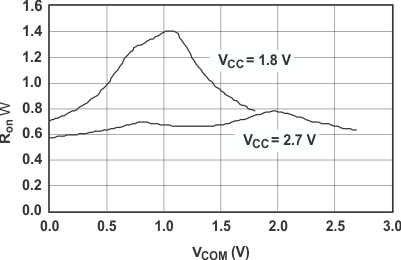
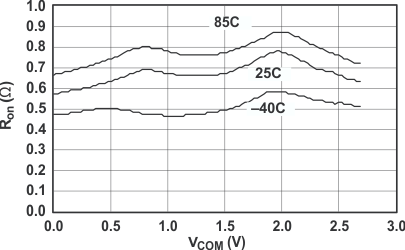
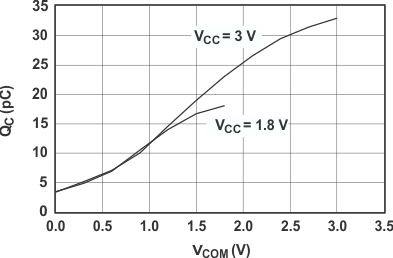
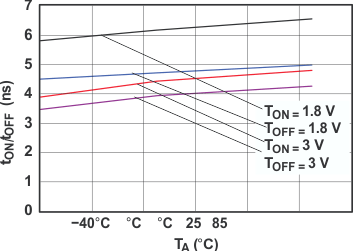 Figure 7. tON and tOFF vs Temperature
Figure 7. tON and tOFF vs Temperature
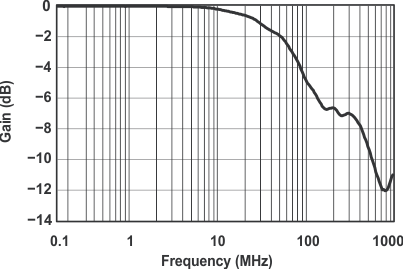 Figure 9. Gain vs Frequency (VCC = 3 V)
Figure 9. Gain vs Frequency (VCC = 3 V)
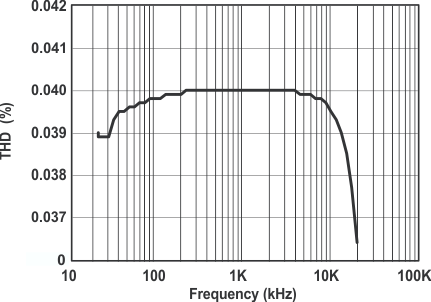 Figure 11. Total Harmonic Distortion vs Frequency
Figure 11. Total Harmonic Distortion vs Frequency (RL = 32 Ω)
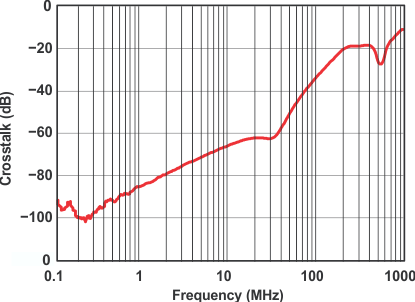 Figure 13. Crosstalk vs Frequency
Figure 13. Crosstalk vs Frequency(VCC = 3 V)
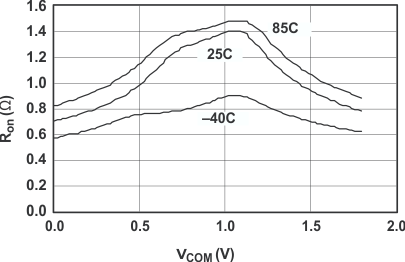
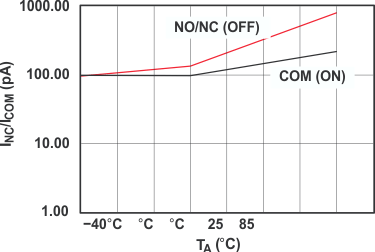
(VCC = 3.6 V)
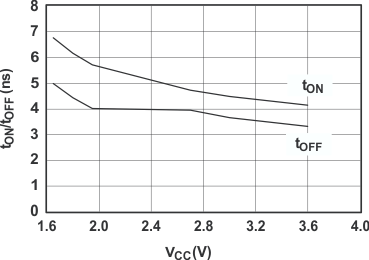
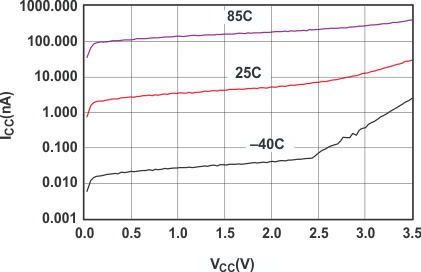 Figure 8. ICC vs VCC
Figure 8. ICC vs VCC
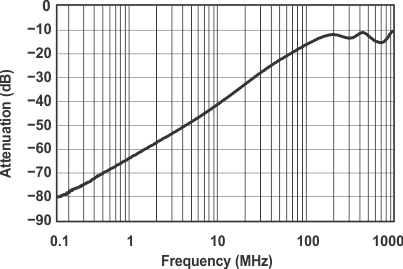 Figure 10. OFF Isolation vs Frequency
Figure 10. OFF Isolation vs Frequency(VCC = 3 V)
 Figure 12. Total Harmonic Distortion vs Frequency
Figure 12. Total Harmonic Distortion vs Frequency (RL = 600 Ω)